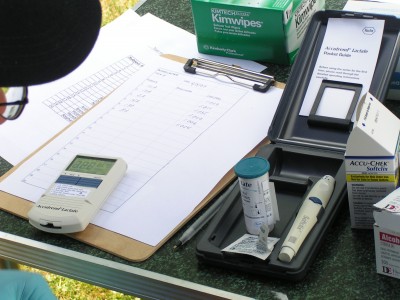
When most people think about dehydration — if they think about it at all — they probably associate it with physical exertion or athletic performance. But a Neag professor’s latest research shows that dehydration can result even from leisurely activity such as sitting at a computer, with possibly detrimental health consequences.
Lawrence Armstrong, who has spent more than 20 years working in the Department of Kinesiology’s Human Performance Laboratory, says despite the popularity of bottled water, most people walk around mildly dehydrated most of the time because when they experience thirst, they may already be dehydrated by 1 to 2 percent of body weight.
“We sometimes don’t think to drink,” says Armstrong. “The average person loses about 2.5 quarts of fluid per day. We have this constant turnover that has to be maintained with frequent hydration, but people get busy and forget. That can reduce mental performance and alter mood, even at a low level of dehydration.”
A recent study Armstrong conducted with fellow Neag professors Carl Maresh and Douglas Casa showed that the effects of even mild dehydration can range from headache to fatigue to problems with concentration. But the research also found that there were effects on mood and feelings. “We saw that these subjects generally felt more tense, more anxious, that they experienced more confusion, all as a result of their mildly dehydrated state. We believe that these findings confirm that all of us can perform optimally only when we are adequately hydrated.”
Armstrong says that past research has focused on severe dehydration, leaving the milder forms neglected. Most previous studies, he adds, have also targeted the consumption of sports drinks rather than water. With research funding from Danone, the second-largest bottled water producer in the world, Armstrong has delved more deeply into water’s effects on hydration and health.
In his book, Performing in Extreme Environments, Armstrong developed a urine color chart that, in his words, was “not rocket science” but did re-think old concepts. “This chart is accessible and easy to understand,” Armstrong says. “The gradations are clearer, showing that if urine is straw-colored or pale yellow, the body is releasing water and the person is well-hydrated. A darker color shows the body is conserving water because it is in a state of dehydration. People get this.”
Coupled with his work on hydration here at home, Armstrong has also been a strong advocate for proper hydration in the developing world. In a recent presentation at a medical conference in Indonesia, he saw the difficulties firsthand. Despite being housed at one of the country’s finest hotels, he saw warning signs telling guests not to drink the tap water. In addition, though it is a nation of more than 220 million people, Indonesia’s sewage treatment and potable water sources are not available to even a majority of its citizens. Thus, dehydration can result from either the intestinal ailments that occur from drinking unsafe water or from not drinking water at all.
Armstrong cites one hopeful development. Third-world physicians may be doing more to advise patients about hydration because they are finally learning more about it themselves, partially as a result of presentations like his. “Physicians have not been trained to talk to their patients about hydration states,” he says. “That’s why I felt my talk in Jakarta opened a lot of eyes to this problem and to the need for administrators to incorporate this kind of training into the Medical School curriculum.” Armstrong also hopes it eventually will lead to action by the Indonesian government to provide an adequate supply of clean drinking water for its people.
The U.S. has, of course, made steady progress over the past 20 to 30 years in terms of its understanding of hydration. Armstrong credits professional organizations, like the American College of Sports Medicine, for raising awareness of the need for adequate daily hydration. He also cites enhancements in the education of athletic trainers, including those in the Neag School’s Department of Kinesiology, for triggering increased awareness.
“The competencies of athletic trainers have changed over the years, due in part to the efforts of my colleague, Doug Casa. Those changes are the little steps that have done so much to benefit so many people,” Armstrong says. “Now, we should disseminate this information and awareness to as much of the rest of the world as we can.”
 Facebook
Facebook
 Twitter
Twitter
 LinkedIn
LinkedIn
